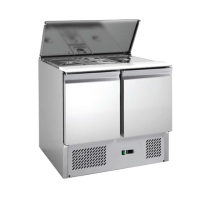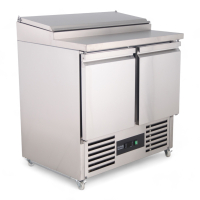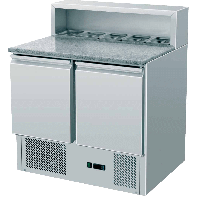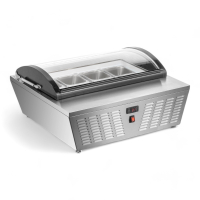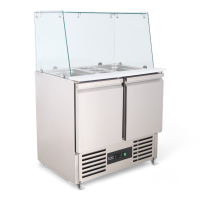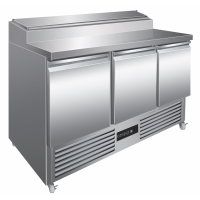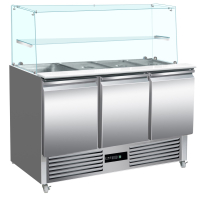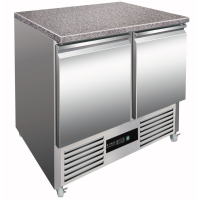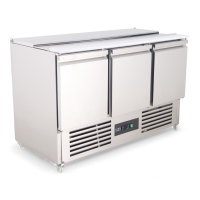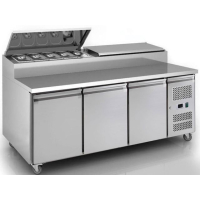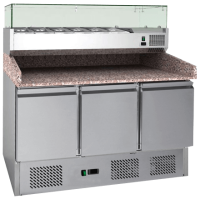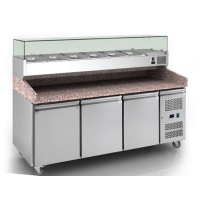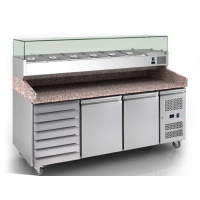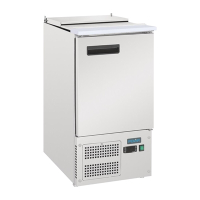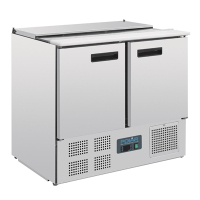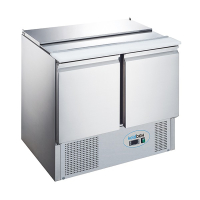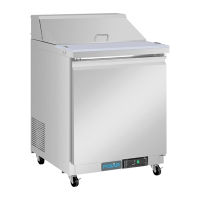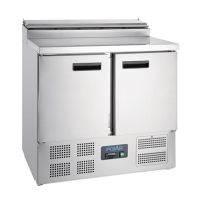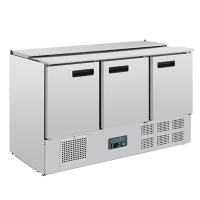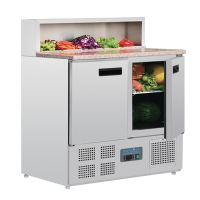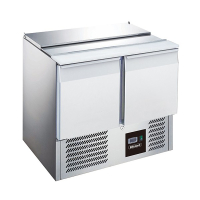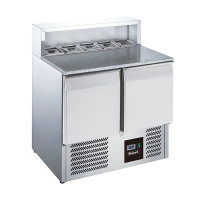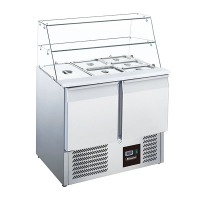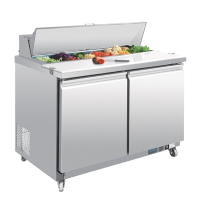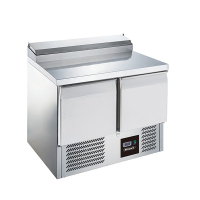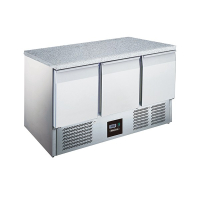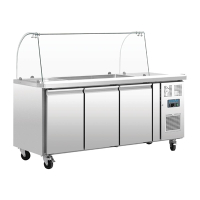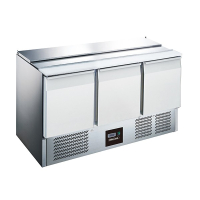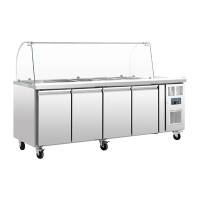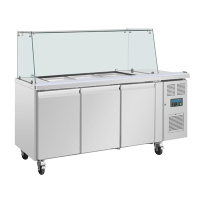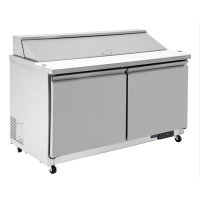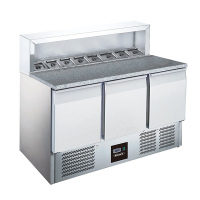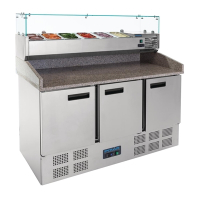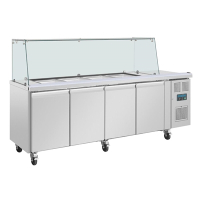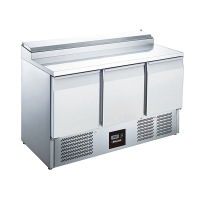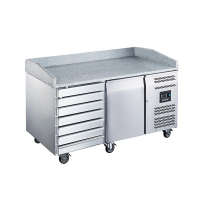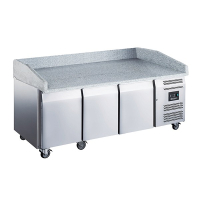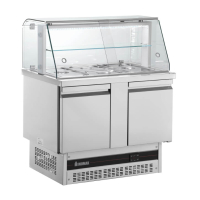Pizza Salad Prep Counters
Commercial Pizza and Salad Prep Counters are essential workhorses for UK restaurants, pizzerias, and takeaways needing efficient food preparation. These refrigerated stations combine chilled storage below with convenient topping containers above—perfect for busy services. With stainless steel construction and temperature ranges of 2-8°C, they keep ingredients fresh while providing a dedicated workspace. After 50 years supplying the industry, we've seen how these units transform kitchen workflows when paired with pizza ovens and dough mixers. For restaurants serious about fresh preparation and swift service, they're absolutely non-negotiable!
Explore More About Pizza Salad Prep Counters
Get expert guidance, see real chef stories, and find answers to your most common questions.
We Recommend
Refrigerated Salad Prep Counter | Commercial Salad Bar | 2 Door Stainless Steel | King KST900.HD
- 2 solid door counter fridge with preparation top
- Holds up to 2 x GN 1/1 and 3 x GN1/6 containers (up to 150 mm deep - sold seperately.)
- Chopping board size: length 900 mm x 100 mm deep
- Insulation thickness: 50 mm.
- Static cooling with fan.
-
Refrigerated Salad Prep Counter | Commercial Salad Bar | 2 Door Stainless Steel | King KST900.HD
70 KGIn Stock
850H x 900W x 700D mm
13 amp plug fitted
2 x GN 1/1 pans, 3 x 1/6 pans (not included)
Stainless Steel
£399.99 £1,247.00 -
Commercial Refrigerated Prep Counter | 2 Door Undercounter Fridge | Stainless Steel | King KSC200.HD
70 KGout of stock
900H x 900W x 700D mm
13 amp plug fitted
8 x GN 1/6 pans (not included)
Stainless Steel
£439.99 £1,069.00 -
Refrigerated Pizza Prep Counter | 2 Door Prep Fridge | Granite Top | King KPS900.HD
70 KGout of stock
1100H x 900W x 700D mm
13 amp plug fitted
5 x GN 1/6 pans (not included)
Stainless Steel
£464.99 £1,069.00 -
Countertop Display Prep Fridge | Refrigerated Showcase | 4 x GN1/3 Capacity | Curved Glass | King CW67
25In Stock
365H x 805W x 650D mm
13 amp plug fitted
67 Litres
R290 refrigerant
£499.99 £994.00 -
Commercial Refrigerated Pizza Prep Counter | Salad Prep | 2 Door with Glass Display | King GST900.HD
60 KGIn Stock
850H x 900W x 700D mm
13 amp plug fitted
2 x 1/1 GN pans & 3 x 1/6 GN pans (not included)
Stainless Steel
£529.99 £1,287.00 -
Commercial Pizza Prep Counter | Refrigerated Sandwich Prep Station | 3 Door | King Z3K.HD
100 KGout of stock
900H x 1365W x 700D mm
13 amp plug fitted
7 x 1/3 GN pans (not included)
Stainless Steel
£629.99 £1,540.00 -
Commercial Pizza Prep Counter | 3 Door Refrigerated Counter | Marble Granite Top | King KPS1365.HD
120 KGout of stock
850H x 1365W x 700D mm
13 amp plug fitted
7 x GN 1/6 pans (not included)
Stainless Steel
£649.99 £1,663.00 -
Commercial Refrigerated Pizza Prep Counter | Salad Prep Table | 3 Door with Glass Display | King GST1365.HD
107KGout of stock
885H x 1365W x 700D mm
13 amp plug fitted
4 x GN1/1 Pans (not included)
Stainless Steel
£659.99 £1,881.00 -
🎯 Need Help Choosing the Right Pizza Salad Prep Counters?
Discover how to choose the right model with expert advice on buying considerations, kitchen-tested usage tips, frequently asked questions and real-world chef insights below.
🎧 On the go? Listen to our expert podcast instead -
Refrigerated Counter | Marble Top Prep Counter | Double Door 240L | King MBT900
In Stock
900H x 900W x 700D mm
13 amp plug fitted
240 litres
Stainless Steel
£699.99 £1,386.00 -
Commercial Refrigerated Salad Prep Counter | 3 Door Prep Fridge | Pizza Prep Table | King KST1365.HD
70 KGIn Stock
900H x 1365W x 700D mm
13 amp plug fitted
9 x GN1/3 and 6 x GN 1/6 pans (not included)
Stainless Steel
£699.99 £1,465.00 -
Commercial Refrigerated Counter | 3 Door Fridge with Marble Work Top | 368 Litre Capacity | King MBT1365
out of stock
900H x 1365W x 700D mm
13 amp plug fitted
368 Litres
Stainless Steel
£799.99 £1,663.00 -
Commercial Pizza Prep Counter | 3 Door Refrigerated Prep Table | 1.8m Chilled Storage | King KPT187
In Stock
860H x 1800W x 700D mm
13 amp plug fitted
8 x 1/3 GN pans (not included)
Stainless Steel
£949.99 £2,560.00 -
Commercial Pizza Prep Counter | Refrigerated Topping Unit | 3 Door 1.4m | King KP14.HD
200 KGout of stock
1415H x 1365W x 700D mm
2 x 13 amp plug fitted
4 x GN1/3 & 2 x GN1/4 pans (not included)
Stainless Steel
£999.99 £2,100.00 -
Commercial Refrigerated Pizza Prep Counter | Extra Large 3 Door Pizza Prep Table | 2m Granite Top | King LPP8.HD
250out of stock
1415H x 2020W x 800D mm
2 x 13 amp plug fitted
9 x 1/3 GN pans (not included)
Stainless Steel
£1,249.99 £3,000.00 -
Commercial Refrigerated Pizza Prep Counter | Granite Top Pizza Counter | 2m 2 Doors 7 Drawers | King LPP9.HD
250out of stock
850H x 2020W x 800D mm
2 x 13 amp plug fitted
9 x 1/3 GN pans (not included)
Stainless Steel
£1,349.99 £3,600.00 -
Polar G-Series Energy Efficient Countertop Prep Fridge 4x GN 1/3 GP293
22.5In Stock
328H x 767W x 612D mm
Polar
67Ltr
Stainless Steel & Glass
£468.99 £917.98 -
Commercial Saladette Prep Counter | Single Door Fridge | For Food Preparation | Polar G-Series GH333
41kgIn Stock
857H x 438W x 700D mm
13 amp plug in
109Ltr
Stainless Steel
£567.99 £1,115.98 -
Commercial Refrigerated Saladette Counter | Prep Counter | 240 Litre Capacity | Polar G606
86.2In Stock
885H x 900W x 700D mm
13 amp plug fitted
1/1 GN interior
Stainless Steel
£612.99 £1,205.98 -
Commercial Saladette | 2 Door Compact Gastronorm Prep Fridge | 240L Capacity | Koldbox KXCC2-PREP
In Stock
877H x 903W x 700D mm
Koldbox
Internal corners rounded to aid cleaning
Stainless Steel
£679.99 £1,136.00 -
Commercial Prep Counter Fridge | Mega Top Single Door | 154L Capacity | Polar U-Series UA009
102kgout of stock
1100H x 735W x 760D mm
13 amp plug fitted
154Ltr
Forced air cooling ensures rapid temperature recovery
£684.99 £1,349.98 -
Commercial Pizza Prep Counter | Refrigerated Salad Prep Station | 254 Litre Capacity | Polar G604
80kgIn Stock
1010H x 900W x 700D mm
13 amp plug fitted
5 x 1/6 GN counter top area
Stainless Steel
£711.99 £1,403.98 -
Commercial Refrigerated Saladette Counter | Prep Fridge | 368 Litre | Polar G607
122out of stock
885H x 1370W x 700D mm
13 amp plug fitted
368Ltr
Stainless Steel
£729.99 £1,439.98 -
Refrigerated Pizza Prep Counter | Commercial Pizza Topping Fridge | 288 Litre Capacity | Polar G603
113.5In Stock
1100H x 900W x 700D mm
13 amp plug fitted
288Ltr
Stainless Steel
£738.99 £1,457.98 -
Commercial Gastronorm Prep Counter | 2 Door Refrigerated Prep Station | 240L Capacity | Koldbox KXCC2-SAL
In Stock
961H x 903W x 700D mm
Koldbox
Internal corners rounded to aid cleaning
Stainless Steel
£856.99 £1,433.00 -
Commercial Gastronorm Saladette | 3 Door Compact Refrigerated Counter | 368L Capacity with Cutting Board | Koldbox KXCC3-PREP
out of stock
877H x 1368W x 700D mm
Koldbox
Internal corners rounded to aid cleaning
Stainless Steel
£986.99 £1,650.00 -
Commercial Pizza Prep Counter | Refrigerated Salad Counter | 390 Litre Capacity | Polar G605
140out of stock
1010H x 1370W x 700D mm
13 amp plug fitted
8 x 1/4 GN counter top area
Stainless Steel
£1,026.99 £2,033.98 -
Commercial Saladette | 2 Door Compact Gastronorm Refrigerator | With Cutting Board | 240L Capacity | Blizzard BSP2
In Stock
877H x 903W x 700D mm
Blizzard
Internal corners rounded to aid cleaning
Stainless Steel
£1,057.99 £1,769.00 -
Commercial Pizza Prep Counter | 2 Door Gastronorm Fridge | 240L Capacity | Granite Top | Blizzard BCC2PREPGRANITE
In Stock
1086H x 903W x 700D mm
Blizzard
High grade AISI 304 stainless steel exterior & interior
Stainless Steel
£1,070.99 £1,790.00 -
Commercial Gastronorm Prep Station | Refrigerated Counter | 2 Door Compact with 240L Capacity | Blizzard BPD2
In Stock
1289H x 903W x 700D mm
Blizzard
Internal corners rounded to aid cleaning
Stainless Steel
£1,076.99 £1,800.00 -
Commercial Gastronorm Prep Counter | 3 Door Refrigerated Counter | 392L Capacity with Raised Collar | Koldbox KXCC3-SAL
In Stock
961H x 1368W x 700D mm
Koldbox
Internal corners rounded to aid cleaning
Stainless Steel
£1,113.99 £1,862.00 -
Commercial Preparation Counter | 2 Door Refrigerated Counter | 405 Litre Capacity | Polar GD882
146In Stock
1097H x 1225W x 760D mm
13 amp plug fitted
405Ltr
Stainless Steel
£1,134.99 £2,249.98 -
Commercial Gastronorm Prep Counter | 2 Door Refrigerated Prep Station | 254L Capacity | Blizzard BCC2EN
In Stock
1002H x 903W x 700D mm
Blizzard
Internal corners rounded to aid cleaning
Stainless Steel
£1,143.99 £1,912.00 -
Commercial Gastronorm Counter | Refrigerated Prep Counter | Granite Worktop | 368L Capacity | Blizzard BCC3-GR-TOP
In Stock
866H x 1368W x 700D mm
Blizzard
Attractive granite worktop
Stainless Steel
£1,178.99 £1,971.00 -
Commercial Triple Door Refrigerated Saladette Counter | Gastronorm Prep Fridge | Energy Efficient | Polar U-Series G607
106kgout of stock
1360H x 1795W x 700D mm
13 amp plug fitted
3 x 1/1 GN
Stainless Steel
£1,179.99 £2,339.98 -
Commercial 3 Door Gastronorm Saladette | Compact Refrigerated Prep Counter | With Cutting Board | 368L Capacity | Blizzard BSP3
In Stock
877H x 1368W x 700D mm
Blizzard
Internal corners rounded to aid cleaning
Stainless Steel
£1,268.99 £2,122.00 -
Commercial Refrigerated Saladette Counter | Four Door Gastronorm Prep Fridge | U-Series | Polar CT395
130kgIn Stock
1360H x 2230W x 700D mm
13 amp plug fitted
4 x 1/1 GN
Stainless Steel
£1,269.99 £2,519.98 -
Commercial Saladette Counter | GN Prep Counter | Square Sneeze Guard | 3 Door | Polar U-Series UA018
106kgout of stock
1360H x 1795W x 700D mm
13 amp plug in
456Ltr
Stainless Steel
£1,314.99 £2,609.98 -
Commercial 2 Door Preparation Counter | Refrigerated Prep Fridge | 527 Litre Capacity | Polar GD883
169out of stock
1097H x 1555W x 760D mm
13 amp plug fitted
527 Litre
Stainless Steel
£1,346.43 £2,672.86 -
Commercial Gastronorm Prep Station | 3 Door Prep Fridge | 368L Capacity with Display | Blizzard BPD3
In Stock
1289H x 1368W x 700D mm
Blizzard
Internal corners rounded to aid cleaning
Stainless Steel
£1,351.99 £2,259.00 -
Commercial Pizza Prep Counter | 3 Door Compact Gastronorm Fridge | 368L Capacity | Blizzard BCC3PREPGRANITE
In Stock
1086H x 1368W x 700D mm
Blizzard
High grade AISI 304 stainless steel exterior & interior
Stainless Steel
£1,377.99 £2,302.00 -
Commercial Pizza Prep Counter | Refrigerated Salad Prep Station | 368 Litre Capacity | Polar CN267
170kgout of stock
1445H x 1400W x 700D mm
2 x 13 amp plug fitted
368Ltr
Stainless Steel
£1,440.99 £2,861.98 -
Commercial Saladette Counter | Refrigerated Pizza Prep Table | 4 Door with Sneeze Guard | Polar U-Series UA019
130In Stock
1360H x 2230W x 700D mm
13 amp plug in
616Ltr
Stainless Steel
£1,449.99 £2,879.98 -
Commercial Gastronorm Prep Counter | 3 Door Refrigerated Prep Unit | 392L Capacity | Raised Collar | Blizzard BCC3EN
In Stock
1002H x 1368W x 700D mm
Blizzard
Internal corners rounded to aid cleaning
Stainless Steel
£1,564.99 £2,616.00 -
Commercial Prep Counter | Gastronorm 1/1 Refrigerator | 2 Door with Raised Collar | 282L | Blizzard HBC2EN
In Stock
1075H x 1360W x 700D mm
Blizzard
Even air distribution by ducted system
Stainless Steel
£1,747.99 £2,921.00 -
Commercial Gastronorm Saladette | 3 Door Refrigerated Counter | 429L Capacity | Inomak ZNV999-HC
out of stock
870H x 1810W x 700D mm
Inomak
1 x GN1/1 shelf supplied per door
Stainless Steel
£1,928.99 £3,032.00 -
Commercial Pizza Prep Counter | 2 Door Refrigerated Pizza Table | 390L Capacity | Blizzard BPB1500
In Stock
990H x 1510W x 800D mm
Blizzard
White granite worktop
Stainless Steel
£1,946.99 £3,255.00 -
Commercial Gastronorm Saladette | 2 Door Prep Fridge | With Cutting Board | 245L Capacity | Inomak BSV77-HC
In Stock
905H x 1080W x 700D mm
Inomak
1 x GN1/1 shelf supplied per door
Stainless Steel
£1,994.99 £3,334.00 -
Commercial Pizza Prep Counter | 3 Door Gastronorm Refrigerator | 368L Capacity | Blizzard BCC3PIZZA
In Stock
1541H x 1400W x 700D mm
Blizzard
Granite work top with granite upstand to support refrigerated preparation top
Stainless Steel
£2,033.99 £3,399.00 -
Commercial Pizza Prep Counter | Pizza Prep Station | 1 Door with Neutral Drawers | 390L Capacity | Blizzard BPB1500-7N
In Stock
990H x 1515W x 800D mm
Blizzard
White granite worktop
Stainless Steel
£2,351.99 £3,931.00 -
Commercial Pizza Prep Counter | 3 Door Refrigerated Worktop | 580L Capacity | Blizzard BPB2000
out of stock
990H x 2020W x 800D mm
Blizzard
White granite worktop
Stainless Steel
£2,355.99 £3,938.00 -
Commercial Saladette | 2 Door Gastronorm Refrigerator | 232L Capacity | Display Unit | Inomak BSV7300-HC
In Stock
1300H x 1080W x 700D mm
Inomak
1 x GN1/1 shelf supplied per door
Stainless Steel
£2,476.99 £4,140.00 -
Commercial Pizza Prep Counter | 2 Door Refrigerated Prep Fridge | 580L Capacity | With Neutral Drawers | Blizzard BPB2000-7N
In Stock
990H x 2025W x 800D mm
Blizzard
White granite worktop
Stainless Steel
£2,669.99 £4,463.00
Commercial Pizza & Salad Prep Counters for Restaurants & Pizzerias
Brands Trusted by Industry Professionals
Key Features and Benefits
- Controlled Refrigeration Maintains perfect 2-8°C for ingredient freshness throughout service.
- Integrated Workspace Combines prep area and refrigeration—everything in one place.
- Gastronorm Compatibility Fits standard-sized ingredient containers for easy prep and restocking.
- Durable Stainless Steel Built to withstand busy kitchen environments for years.
- Adjustable Temperatures Fine-tune cooling to suit different ingredients and conditions.
- Multiple Door Options Choose 2-4 doors depending on your volume needs.
- Forced-Air Cooling Ensures even temperature throughout—no warm spots.
- Energy-Efficient Design Keeps operating costs down with modern refrigeration technology.
Too busy to read? Listen instead.
In this episode of The Deep Dive, we reveal the ins and outs of pizza & salad prep counters. Learn how they keep ingredients chilled, can be organized for speed & efficiency, and ensure food safety—ideal for pizzerias, delis, and salad bars.
16.05min | Expert-led | Real-world advice
0:00: Welcome to the deep dive.
0:01: Today we're really zeroing in on commercial pizza and salad prep counters.
0:06: That's right.
0:07: Our sources today, they're from E equipment.
0:09: They've got what, half a century of experience supplying the UK restaurant scene.
0:14: Yeah, 50 years, they know their stuff.
0:17: And our mission really is to figure out why they call these units non-negotiable.
0:22: You know, not just helpful, but absolutely essential for places wanting fresh food, served fast.
0:28: Exactly.
0:29: And easy equipment, they offer, well, a huge range of gear, bottle coolers, ice machines, ovens, loads of things.
0:37: But we're diving into that specific pizza salad prep counters category today found under commercial fridges on their site.
0:44: OK, so prep.
0:45: It's more than just like a fridge with a shelf on top, right?
0:49: What's the core idea?
0:50: Yeah, totally more than that.
0:51: It's a clever mix really.
0:53: Down below you've got properly chilled storage.
0:55: We're talking 2 to 8 °C usually.
0:58: OK, that's the key temperature range.
0:59: Absolutely crucial.
1:00: Keeps ingredients safe, you know, out of that danger zone between 5 and 60 degrees where bacteria love to grow.
1:06: Then on top of that fridge base, there's a dedicated workspace and it's designed to hold all your toppings, your ingredients right there.
1:14: Ready for assembly.
1:15: , so it's like your cold storage and your production line all rolled into one.
1:20: Makes you think, doesn't it?
1:22: Those super efficient kitchens you see sometimes.
1:24: You're probably watching one of these in action.
1:26: Ever been just amazed at how fast a pizza or salad gets made.
1:30: This must be a huge part of that speed.
1:33: Oh, it is, and it's not just about shaving off seconds though it does that too, that integrated design, it fundamentally changes the kitchen workflow.
1:41: No more running back and forth to a separate fridge.
1:43: Everything's right there.
1:44: Like your fingertips.
1:46: Exactly.
1:46: It speeds things up, sure, but also helps keep those ingredients top quality because they stay chilled right until you use them.
1:53: So yeah, let's dig into some of those key features, see why they're non-negotiable.
1:58: OK, first up, that controlled cooling, the 2 to 8 degrees, we mentioned food safety, but.
2:05: Why else is that so vital for a business?
2:07: Well, beyond stopping bacteria, which is obviously paramount.
2:11: Yeah.
2:11: That consistent chill preserves the quality.
2:15: Think crisp lettuce, bright tomatoes, you know, good quality sliced meats, keeping them in that range means they hold their texture, their flavor, their whole appeal for longer, which directly impacts the final product the customer gets.
2:28: Absolutely.
2:28: Better taste, fresher food, simple as that.
2:31: And the integrated workspace sounds simple, but having your prep surface right over the chilled stuff, that's got to be a game changer for efficiency.
2:38: Oh, massive.
2:40: If you've ever tried prepping food where your ingredients are, like across the kitchen, you instantly get why this setup works.
2:47: It's just a fundamental improvement.
2:49: Think of the seconds, maybe even minutes, save.
2:51: Every single order adds up quickly over a busy shift.
2:55: Hugely lets you serve more people faster with the same staff.
2:59: Plus, it tends to make the workspace tidier, more organized, less clutter, fewer mistakes.
3:05: Now, gastronome compatibility, that term pops up a lot.
3:08: For those of us not fluent in kitchen speak.
3:10: What's that mean?
3:11: Why care?
3:12: Right, gastronome or GN, you'll hear it called GN.
3:15: It's basically a standard set of sizes for food containers, like universal sizes used all across professional kitchens, like a standard measurement system for food pans.
3:25: Exactly.
3:26: So when a prep counter says it's GN compatible, it means those standard pans fit perfectly into the wells on top.
3:32: OK.
3:32: And the benefit is efficiency swapping ingredients, restocking, organizing.
3:38: It's all streamlined.
3:38: You can pull a GN pan from your main fridge, drop it straight into the prep counter, take it out to clean it.
3:45: No messing about transferring food between different containers.
3:48: Saves time, reduces hassle, maybe even less food waste.
3:51: Definitely helps with portion control and managing stock too, yeah.
3:54: And these counters, they're built tough, right?
3:57: Stainless steel that's not just for looks, I assume.
3:59: Not at all.
4:00: Commercial kitchens are, well, demanding places, constant.
4:03: use heat spills, stainless steel is tough.
4:07: It can take a beating.
4:08: plus it's non-porous, which means it's easy to clean and keep hygienic, really important.
4:13: So durable and safe, makes the investment worthwhile long term.
4:17: That's the ideas.
4:19: The adjustable temperature feature also sounds useful.
4:22: Guessing not all ingredients want the exact same chill.
4:25: Precisely.
4:26: That 2 to 8 range is great generally, but maybe you want your salad greens slightly cooler than your cooked meats within that range.
4:32: Adjustability gives you that fine tuning ability, optimize it for whatever you're storing, maximize freshness, and shelf life.
4:39: And they come in different sizes, 234 doors, clearly about matching the unit to the kitchen's needs, right?
4:45: Small takeaway versus big pizzeria.
4:48: Exactly right.
4:48: A little place with a simple menu, a two door might be plenty.
4:52: Enough storage, enough workspace, but a busy city place.
4:55: Yeah, high volume, lots of different toppings.
4:58: They'll need the bigger capacity of a 3 or 4 door model, more topping space on top, plus way more storage underneath for backups.
5:05: It's all about scaling the gear to your actual output.
5:08: Makes sense.
5:09: Then there's forced air cooling.
5:11: Hear that about home fridges too, but what's the advantage?
5:14: Consistency, that's the key.
5:16: Forced air uses fans to push the cold air all around the unit.
5:20: Top and bottom.
5:21: Both the storage area below and the ingredient wells up top.
5:24: It gets rid of warm spots you might find in simpler static cooling systems.
5:29: so everything stays at the right temperature, no matter where it is in the unit.
5:32: Exactly, which is vital for food safety, obviously, but also just for keeping all those different ingredients at their best quality and energy efficiency always a big factor now.
5:42: Lower running costs.
5:43: Absolutely.
5:45: Modern units are much better these days.
5:47: Good insulation, efficient compressors, smarter controls, they all help cut down electricity use, which means lower bills, good for the planet, good for the pocket.
5:56: That's it, makes financial sense alongside being a bit greener.
6:00: OK, so we get the features, the benefits.
6:02: If someone's actually looking to buy one, what are the absolute must think abouts before they splash the cash?
6:08: Number one, size and capacity.
6:11: Measure your space.
6:12: Carefully, they go from 900 millimeters up to 2.5 m wide.
6:16: Huge range, it is.
6:17: So measure first.
6:18: Then think hard about your menu.
6:20: How many different topping containers those GN pans do you actually need out and ready?
6:25: Right, depends on the complexity of your pizzas or salads.
6:27: Totally.
6:28: And don't forget the storage underneath.
6:30: Will a two-door hold enough backup stuff, or do you need a 3 or 4 door for your volume?
6:35: Match the size and the capacity to what you actually do?
6:38: And workflow, installation, you mentioned positioning it near the oven, but not too near, that sounds important.
6:43: Yeah, it's about creating a smart layout.
6:46: You want it handy for the pizza station, obviously, but stick it right next to a hot oven and it's going to struggle to stay cool.
6:52: Work harder, use more energy.
6:54: Exactly, and check the plug.
6:56: Most are standard 13 amp plugs here in the UK, but just double check.
7:01: Avoids hassle later.
7:03: Good practical tip and refrigerant type.
7:05: You mentioned R290 earlier as being better for the environment.
7:08: Yeah, R290 is a natural hydrocarbon, much lower impact on global warming compared to older types of refrigerants.
7:15: Choosing an R290 unit is, well, more sustainable, could be important with future regulations too.
7:21: Looks better for the business image as well, perhaps.
7:23: OK, good point.
7:24: So features, buying tips.
7:26: Let's get practical.
7:28: How do these things actually work day to day?
7:29: Paint us that picture.
7:30: OK, so imagine the bottom part.
7:33: It's basically a solid commercial fridge.
7:36: Shelves you can adjust, temperature control keeping everything nice and cool, 2 to 8 degrees, your workhorse storage.
7:42: Got it, reliable fridge underneath.
7:45: Then the top surface, often stainless steel, sometimes even granite, nice and tough for working on rolling dough, whatever, and built into that worktop are the refrigerated wells designed perfectly to hold those GM containers full of your chopped peppers, shredded cheese, olives.
8:03: All your ingredients.
8:04: OK, I see it.
8:05: So you're literally standing there working right above your chilled supply, super streamlined.
8:09: That's exactly it.
8:10: And that forced air cooling we talked about, it chills those topwells too.
8:14: keeps the toppings cold even when they're out.
8:16: Yeah, circulates cold air constantly.
8:18: So even during a mad rush when the lids might be off a lot, those ingredients stay properly chilled.
8:23: A chef can stretch dough, reach over, grab toppings, boom, boom, boom, no walking away, everything cold, everything close.
8:30: That sounds incredibly smooth.
8:31: We actually have a quote here from Marco Romano, a pizza equipment specialist.
8:35: He says, when you're tossing dough and prepping toppings, A good pizza prep counter is your best friend, cold storage below, workspace on top, and everything within arm's reach.
8:46: Trust me, the right setup keeps your kitchen flowing smoother than melted mozzarella.
8:51: Huh.
8:52: Great analogy, and he's spot on.
8:54: It just optimizes that crucial prep stage.
8:57: But like any food equipment, safety's got to be top of mind, right?
9:00: What are the absolute must-do safety guidelines?
9:03: Oh, definitely.
9:04: First off, daily temperature checks.
9:06: Use a proper probe thermometer.
9:08: Make sure it's staying in that safe 28 degree C zone.
9:11: No guessing, absolutely.
9:13: Then rigorous cleaning every day.
9:16: Sanitize the work surfaces, wash out those ingredient containers, prevent any cross-contamination risk.
9:21: Makes sense.
9:22: Also, never block the air vents.
9:24: The unit needs to breathe to cool properly.
9:26: Well, don't stack boxes against it.
9:27: Exactly.
9:28: Use a FIFO system first in, first out for your ingredients.
9:32: Rotate your stocks so you're always using the oldest first.
9:35: Cuts waste, ensures freshness, and a big one.
9:39: Never ever switch the unit off if there's still food inside.
9:43: Obvious maybe, but crucial.
9:45: Things will spoil fast.
9:47: And finally get it professionally serviced once a year, just keeps it running safely and efficiently.
9:52: Good checklist and to really get the most out of them, any top tips for actually using the counters day to day.
9:58: Yeah, a few simple things help.
10:00: Pre-chill it, turn it on for at least a couple of hours before you load it up with food.
10:05: Get it down to temperature properly.
10:07: Good tip.
10:08: When things are slow, keep the lids on the topping containers, helps maintain the temperature, stop stuff drying out.
10:14: Clean those GN pans daily, definitely, and give the air filter a quick, clean weekly helps with airflow and efficiency.
10:22: OK.
10:22: Think about layout when you load it.
10:24: Arrange your toppings logically for how you build your pizzas or salads, speed things up.
10:29: Like an assembly line.
10:30: Pretty much.
10:31: And keep backups of your main ingredients in the main walk-in fridge or another fridge.
10:36: Avoids running out mid-service.
10:38: Smart planning.
10:39: So putting all this together, what are the real tangible payoffs for a business investing in one?
10:45: The bottom line benefits.
10:47: Well, the biggest one usually mentioned is time, big time savings.
10:51: Easy equipment, reckon it can speed up service by like 40%, 40%.
10:56: That's huge.
10:57: It's a massive difference per order.
10:59: Then obviously fresher ingredients.
11:01: Keeping stuff at the perfect temperature means better quality, better taste.
11:05: Customers notice that.
11:06: Happy customers, repeat business, exactly, and less waste.
11:11: Proper cooling makes ingredients last longer, less stuff getting thrown out, which saves money directly.
11:16: Time, quality, less waste.
11:18: Strong arguments and the numbers back it up, you know, a good setup can help a team knock out like 100 pizzas an hour.
11:25: Wow, yeah.
11:26: Or think about this.
11:27: Being just 1 degree C off the ideal temperature can cut the shelf life of some things by 25%.
11:33: It can be.
11:34: And modern units often have auto evaporation for condensation.
11:37: No manual draining needed saves a bit of labor.
11:39: Nice little bonus.
11:40: And look, a good quality counter, if you look after it, it can last 10 years, maybe more.
11:45: Solid investment.
11:46: Really compelling stats, and we have another expert view here from Chris, their refrigeration specialist.
11:52: He says, The right pizza prep counter can boost output by 30%.
11:57: It's all about keeping ingredients accessible and perfectly chilled, the cornerstone of consistent quality.
12:02: Yeah, sums it up well.
12:04: He flags the pros, better workflow, less prep time, food safety.
12:09: It also reminds us, you know, they need regular cleaning and maintenance.
12:12: Sure, it's a responsibility, comes with the territory, but the benefits for the right kind of place way outweigh the.
12:18: So who are these right kind of places who really needs one of these?
12:22: Well, pizzeria is obviously, especially high volume ones.
12:24: It's almost standard kit, yeah, but also any restaurant doing lots of made to order salads, sandwiches, huge benefit for them too.
12:33: Speed, freshness, right, deli counters, cafes, yeah, fast food places assembling burgers or wraps with fresh toppings.
12:40: perfect for them.
12:41: Speeds up the line.
12:42: Even hotel kitchens.
12:43: Think breakfast prep, room service orders, they can really streamline things with one of these surprisingly versatile kit.
12:50: And there's a real world story, right?
12:51: It's a pizzeria in Birmingham.
12:53: Yeah, good example.
12:55: They were struggling with workflow, keeping ingredients fresh.
12:58: They put in a three-door prep counter, paired it with a dough mixer, and the result.
13:02: Owner said prep time was cut in half, literally half.
13:05: The ingredients stayed fresh way longer.
13:08: And overall output jumped by 35%.
13:11: 35% increase.
13:12: That's significant.
13:13: The massive impact on their business, productivity, profit, it all ties together.
13:18: Great case study really shows the difference that can make coming.
13:21: And I bet people considering buying one have common questions.
13:25: What sort of FAQs pop up?
13:26: Yeah, typical stuff like how often to clean.
13:29: Daily for the containers, weekly deep clean for the unit is the usual advice.
13:33: OK, ideal temperature.
13:35: Generally aiming for that 2 to 5 degrees C range within the unit, nice and safe, keeps things crisp.
13:41: Can you leave toppings in overnight?
13:43: Yes, usually fine if they're properly covered with lids and you're following all the food safety rules, right?
13:48: Capacity for toppings depends on the model, but often holds around 6 to 12 of those standard GM 13 size pans.
13:55: Installation.
13:56: Easy or hard?
13:58: Mostly pretty easy plug and play for standard ones, but getting the position right, away from heat, ensuring ventilation, maybe get professional advice on that bit.
14:08: Good idea.
14:08: And can you use a salad prep counter for pizza?
14:11: Often, yes.
14:12: The main difference might just be the layout of the wells on top, but fundamentally they do the same job.
14:17: Worth checking the specifics though.
14:19: And just flicking through, say, the easy equipment site, you see loads of options, don't you?
14:24: Well, yeah, different sizes like we said, 2 door, 3 door, some with stainless steel tops, some with granite.
14:29: Saw some with glass displays too.
14:31: Yeah, if you want customers to see the fresh ingredients.
14:34: Different capacities, different brands, King, polar, blizzard or common ones, loads of choice.
14:40: Really shows there's something for pretty much every budget and every type of kitchen, doesn't it?
14:44: Exactly.
14:45: From small countertop units, right up to big prep tables for massive operations, the variety is huge because the needs are diverse.
14:53: So, wrapping up our deep dive then, it's pretty clear these commercial pizza and salad prep counters.
14:59: They're way more than just a fridge with a shelf.
15:01: Absolutely.
15:02: They're like a central hub for efficiency in any kitchen, dealing with fresh, made to order food.
15:08: Huge impact on speed, quality, waste.
15:12: Yeah, and ultimately, the business's success.
15:14: They cleverly integrate storage and workspace right where you need it most, makes them genuinely indispensable for places serious about doing things well.
15:22: Really makes you think, doesn't it?
15:24: What's the equivalent pizza prep counter?
15:27: In, you know, your own work or daily routine.
15:30: Hm.
15:31: What's that simple tool or system that if you just optimized it could make a massive difference to how efficiently you work or the quality you produce?
15:40: Maybe worth pondering where a bit of streamlining could pay off big time.
15:43: That's a really good takeaway thought.
15:45: And look, for anyone actually in the food business or even just interested in how efficient operations.
15:50: Digging into the details of this kind of equipment, maybe browsing a site like Easy equipment, it's actually quite insightful.
15:57: Yeah, shows how smart design can really change the game.
15:59: Exactly.
16:00: A great example of how innovation, even in something seemingly straightforward, can have a huge impact.

Essential Buying Considerations
Size and Capacity
- Measure your available space carefully—units range from 900mm to 2500mm wide.
- Consider topping capacity—how many GN containers will you need for your menu?
- Factor in undercounter storage—2-door models suit small operations, 3-4 doors for high volume.
Workflow and Installation
- Position near pizza ovens for efficient workflow—but not too close!
- Check voltage requirements—most run on standard 13A but check specs.
- Consider refrigerant type—modern R290 systems are more environmentally friendly.
How Commercial Pizza & Salad Prep Counters Work
These clever units combine refrigeration with accessible workspace—imagine a commercial fridge with a built-in preparation area! The lower section functions as a standard refrigerator with adjustable shelving and temperature control systems maintaining 2-8°C. Above sits the preparation area featuring a durable stainless steel or granite worktop alongside refrigerated ingredient wells (gastronorm containers) that keep toppings fresh and within arm's reach. Most models use forced-air cooling systems that circulate cold air throughout, ensuring even temperature distribution. Simply prep your pizzas or salads directly atop the counter, with everything you need just centimetres away!

Trusted Insights from Marco Romano
![]()
Pizza Equipment Specialist
10+ years experience
Safety Guidelines
- Temperature Monitoring Check daily with a probe thermometer—maintains food safety.
- Regular Cleaning Sanitize surfaces and containers daily—prevents cross-contamination.
- Avoid Overcrowding Don't block air vents—ensures proper cooling.
- Ingredient Rotation Follow FIFO (first in, first out)—prevents waste.
- Proper Shutdown Never switch off with food inside—causes spoilage.
- Professional Servicing Schedule annual maintenance—keeps running efficiently.
Top Tips for Using Commercial Pizza & Salad Prep Counters
For optimal performance, always pre-chill your prep counter for at least two hours before loading ingredients. Keep lids on topping containers during quiet periods to maintain freshness and temperature. Clean gastronorm containers daily, and don't forget weekly cleaning of the air filter to maintain cooling efficiency. Arrange toppings in logical order based on your menu for faster assembly, and consider keeping backup ingredients in your main refrigerator for quick refills during busy periods.
Benefits of Using Commercial Pizza & Salad Prep Counters
- Time Efficiency Speeds up service by 40%—ingredients at your fingertips.
- Fresher Ingredients Maintains perfect temperatures—better tasting food.
- Reduced Waste Proper refrigeration extends ingredient life—saves money.
Did You Know?
- Speed A well-organized pizza prep counter can help produce up to 100 pizzas per hour.
- Temperature Control Just 1°C difference can impact ingredient shelf life by 25%.
- Condensation Modern units use auto-evaporation technology—no manual draining needed.
- Investment Quality prep counters can last 10+ years with proper maintenance.




Expert Insights on Commercial Pizza & Salad Prep Counters
With half a century in the catering equipment game, we've seen countless kitchens transformed by proper prep stations. 'The right pizza prep counter can boost output by 30%,' explains Chris, our refrigeration specialist. 'It's all about keeping ingredients accessible and perfectly chilled throughout service—the cornerstone of consistent quality.'
- Pros: Dramatically improves workflow, reduces prep time, ensures food safety.
- Cons: Requires regular cleaning and maintenance—neglect them and performance suffers.
Who Needs Commercial Pizza & Salad Prep Counters?
- Pizzerias Essential for high-volume pizza production—boosts efficiency.
- Restaurants Perfect for made-to-order salads and sandwiches—fresh every time.
- Fast Food Outlets Speeds up assembly of fresh burger toppings and sides.
- Hotel Kitchens Ideal for breakfast and room service prep—versatile solution.
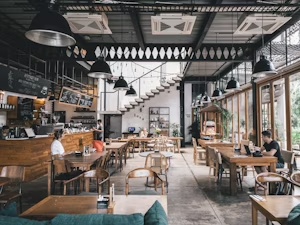
Real-World Success with Commercial Pizza & Salad Prep Counters
A bustling pizzeria in Birmingham was struggling with their kitchen workflow. Orders were backing up during peak times, and keeping ingredients fresh was a constant battle. After installing a three-door pizza prep counter with 12 topping containers, everything changed. 'It's like night and day,' says the owner. 'Our prep time dropped by half, ingredients stay fresher longer, and we've increased output by 35%.' They paired it with a quality dough mixer and now handle weekend rushes with ease—turning tables faster and boosting profits!

FAQs
- How often should I clean my pizza prep counter? Clean topping containers daily and deep-clean the entire unit weekly—maintains hygiene standards.
- What's the ideal temperature for a pizza prep fridge? Between 2-5°C for optimal food safety and ingredient freshness.
- Can I store prepped toppings overnight? Yes, but always use lids and follow proper food storage guidelines.
- How many pizza toppings can a standard unit hold? Typically 6-12 GN 1/3 containers depending on the model size.
- Do they require specialist installation? Most plug-and-play, but professional positioning ensures optimal performance.
- Can salad prep counters also be used for pizzas? Yes, many models are versatile—check container configurations for your needs.
Looking for Equipment by Business Type?
Not sure where to start? Whether you're running a bustling café, opening a pizzeria, or managing a school canteen, we've made it easy to shop by business type. Explore handpicked equipment bundles and essentials tailored to your industry—saving you time and making sure you get exactly what you need.
Other Categories You Might Find Useful
We’ve selected some closely related categories that might be essential for your setup. Whether you’re expanding your kitchen or just making sure you’ve got everything covered, these links will help you explore more equipment that fits your needs.
What our Customers Say
'Transformed our kitchen workflow—prep time cut in half!'
M Marcus Pizzeria Napoli, Bristol'Rock-solid cooling even during summer heatwaves!'
L Lucy The Garden Café, York
Why Choose EasyEquipment for Commercial Pizza & Salad Prep Counters?
- 50 Years Experience Half a century helping UK restaurants find perfect prep solutions.
- Quick Delivery Nationwide shipping—get your kitchen up and running fast.
- Value Promise Competitive pricing without compromising on quality.
- Expert Support Real advice from people who understand commercial kitchens.
Ready to Explore Commercial Pizza & Salad Prep Counters?
Transform your kitchen's efficiency with a professional pizza or salad prep counter. Browse our full range to find the perfect size and configuration for your restaurant—backed by our 50 years of catering expertise and comprehensive support!
#PizzaPrepCounter
- #CommercialKitchen
- #RestaurantEquipment
- #PizzeriaEssentials
- #FoodPrep
- #EasyEquipment
- #UKCatering

